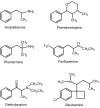Appetite suppressants, cardiac valve disease and combination pharmacotherapy
- PMID: 19092640
- PMCID: PMC2713386
- DOI: 10.1097/MJT.0b013e31817fde95
Appetite suppressants, cardiac valve disease and combination pharmacotherapy
Abstract
The prevalence of obesity in the United States is a major health problem associated with significant morbidity, mortality, and economic burden. Although obesity and drug addiction are typically considered distinct clinical entities, both diseases involve dysregulation of biogenic amine neuron systems in the brain. Thus, research efforts to develop medications for treating drug addiction can contribute insights into the pharmacotherapy for obesity. Here, we review the neurochemical mechanisms of selected stimulant medications used in the treatment of obesity and issues related to fenfluramine-associated cardiac valvulopathy. In particular, we discuss the evidence that cardiac valve disease involves activation of mitogenic serotonin 2B (5-HT2B) receptors by norfenfluramine, the major metabolite of fenfluramine. Advances in medication discovery suggest that novel molecular entities that target 2 different neurochemical mechanisms, that is, "combination pharmacotherapy," will yield efficacious antiobesity medications with reduced adverse side effects.
Figures




References
-
- Anonymous State-specific prevalence of obesity among adults--United States, 2005. MMWR Morb Mortal Wkly Rep. 2006 Sep 15;55(36):985–988. - PubMed
-
- Ogden CL, Yanovski SZ, Carroll MD, et al. The epidemiology of obesity. Gastroenterology. 2007 May;132(6):2087–2102. - PubMed
-
- Bray GA, Champagne CM. Beyond energy balance: there is more to obesity than kilocalories. J Am Diet Assoc. 2005 May;105(5 Suppl 1):S17–23. - PubMed
-
- Bray GA, Hollander P, Klein S, et al. A 6-month randomized, placebo-controlled, dose-ranging trial of topiramate for weight loss in obesity. Obes Res. 2003 Jun;11(6):722–733. - PubMed
-
- Marchesini G, Cuzzolaro M, Mannucci E, et al. Weight cycling in treatment-seeking obese persons: data from the QUOVADIS study. Int J Obes Relat Metab Disord. 2004 Nov;28(11):1456–1462. - PubMed
Publication types
MeSH terms
Substances
Grants and funding
LinkOut - more resources
Full Text Sources
Medical
